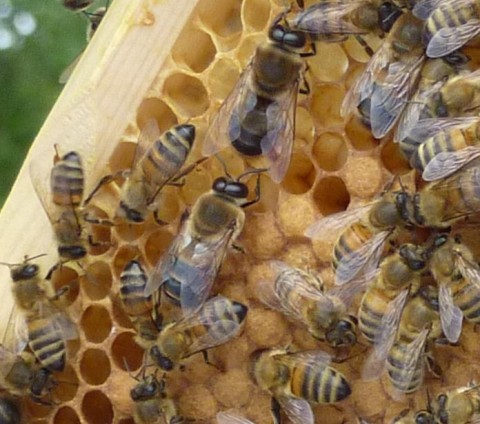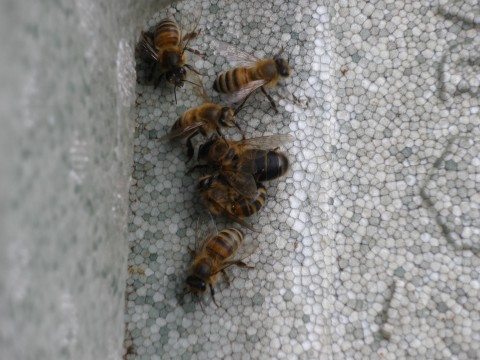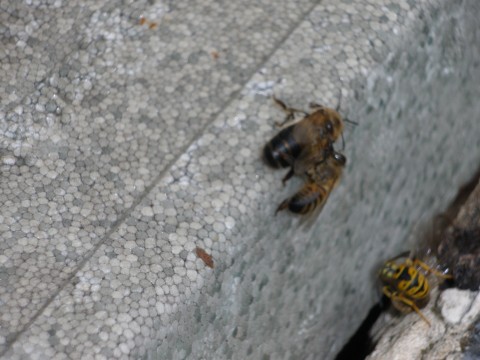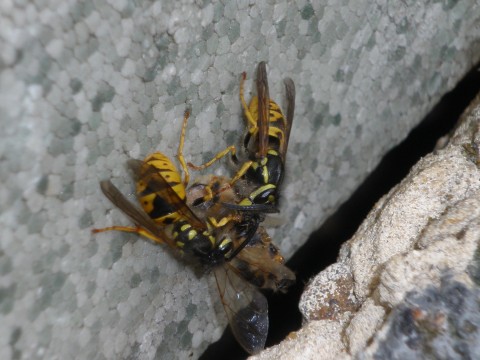 Abraham Lincoln
If given the truth, the people can be depended upon to meet any national crisis...
Abraham Lincoln
If given the truth, the people can be depended upon to meet any national crisis...
 Guildford news...
for Guildford people, brought to you by Guildford reporters - Guildford's own news service
Guildford news...
for Guildford people, brought to you by Guildford reporters - Guildford's own news service
Beekeeper’s Notes September 2015
Published on: 1 Sep, 2015
Updated on: 6 Sep, 2015
Drones Over Guildford
In this month’s Beekeeper’s Notes, Hugh Coakley talks about exploding genitalia and being eaten by wasps, all part of the highs and lows in the life of the drone bee.
Who would choose to be a drone?
On one hand, it does sound attractive. The drone, the male bee, does no foraging, no hive cleaning, no feeding or nurturing of the developing larvae. They don’t have to feed the queen or, as they don’t even have a sting, protect the hive from marauding wasps.

The male bee – drone – is about twice the size of the worker. It has huge eyes – to spot the queen in her mating flight.
The females, the worker bees do all this and much, much more (as the adverts say).
The boys don’t even feed themselves when they are young. The girls, who look after themselves from day one, care for them and make sure that their lads, who make up less than 1% of the colony, are well fed.
The drones only known job is to mate with new queens. Well, that sounds ok.
They strut around the hive, twice the size of the females, and eat. Their massive shoulders and huge eyes mark them out in the mass of bees.
They gather with their mates at drone congregation points waiting for the opportunity to do their entire life’s work. I have heard that there is one such congregation point at the Devil’s Punchbowl at Hindhead. The drones over Guildford (and every other town in the country), hover over 10m above the ground and when a queen approaches, they follow her like a comet’s tale.
There is a beautiful slow motion film made of a queen mating. Click on this link to view it.
As you can see, it is all over in a flash. However, in the case of the drone, it’s more like an explosion. The insides of the successful drone burst out to provide the queen with his precious load. In his moment of triumph, he falls to the ground, dead.

Worker bees at one of my home hives gather around the drone to prevent him entering the hive. As there are no new queens, his services are no longer required, so why feed him?
It’s not much better for those that don’t make it in the mating game. At this time of year, the number of new queens is low. So now that there is little need of the unique services offered by the drones, the workers kick them out of the hive and leave them to the unkind mercies of starvation and predation. Why gather nectar and feed the useless lump when he has nothing more to offer?

A worker bee drags the drone away from the hive entrance. A voracious wasp waits below to attack and eat the defenceless drone.
Life is good for the drone but the end is grim. I don’t suppose that they know what their fate will be and that is probably for the best.
It’s a great life for the drones over Guildford – while it lasts.
Responses to Beekeeper’s Notes September 2015
Leave a Comment Cancel reply
Please see our comments policy. All comments are moderated and may take time to appear. Full names, or at least initial and surname, must be given.Recent Articles
- Thames Water Faces £122 Million Penalty Following Ofwat Inquiry
- New Knife Crime Strategy for Surrey Announced
- Public Asked for Views on SCC’s Proposal for Reduced Speed Limits
- Guildford Healthcare Staff Celebrated for Transformative Mental Health Support
- Will the Government Help Save Community Pubs? Asks Surrey MP
- A Lighthouse in the Centre of Town Showing the Way to Community
- Letter: SCC Directs Weedkilling Policy
- Library Gets Lottery Grant To Raise Awareness of Green Issues
- Story of Wartime Canadian Army Entertainment Unit Based at Down Place, Guildford
- Flashback: Around the Very Top: Slow Progress to Our First Remote Stop


Recent Comments
- J Holt on Millions of Taxpayer Money Recovered from Railway Fare Dodgers
- J Holt on Summary of GBC Planning Decisions – May 21, 2025
- Kit Collins on Letter: Is This the Ugliest Building in Guildford?
- Barbara Ford on Notice: Have a Blooming Picnic – June 7
- M Durant on Millions of Taxpayer Money Recovered from Railway Fare Dodgers
- Jim Allen on Letter: If GBC Wishes To Be Nature-friendly, Stop Spraying Weedkiller
Search in Site
Media Gallery
Dragon Interview: Local Artist Leaves Her Mark At One of England’s Most Historic Buildings
January 21, 2023 / No Comment / Read MoreDragon Interview: Lib Dem Planning Chair: ‘Current Policy Doesn’t Work for Local People’
January 19, 2023 / No Comment / Read MoreA3 Tunnel in Guildford ‘Necessary’ for New Homes, Says Guildford’s MP
January 10, 2023 / No Comment / Read More‘Madness’ for London Road Scheme to Go Ahead Against ‘Huge Opposition’, Says SCC Leader
January 6, 2023 / No Comment / Read MoreCouncillor’s Son Starts Campaign for More Consultation on North Street Plan
December 30, 2022 / No Comment / Read MoreCounty Council Climbs Down Over London Road Works – Further ‘Engagement’ Period Announced
December 14, 2022 / No Comment / Read MoreDragon Interview: GBC Reaction to the Government’s Expected Decision to Relax Housing Targets
December 7, 2022 / No Comment / Read MoreHow Can Our Town Centre Businesses Recover? Watch the Shop Front Debate
May 18, 2020 / No Comment / Read More













Malcolm Fincham
September 1, 2015 at 12:53 am
A truly fascinating column by Hugh Coakley.I found this weeks article especially interesting. The Guildford Dragon news has got to be the front running online newspaper for people to learn about the birds and the bees … And so much more too !
Harry Eve
September 1, 2015 at 9:16 am
Hugh Coakley’s article is much appreciated.
I had not realised that the drones looked so different – or the details of their fate. I believe there are about 250 other species of bee in the UK and they all have interesting lifestyles – some social, some solitary.
Yes, but I am not sure we should have published it. If males of a species get kicked out and sent to an cruel and ignominious end just for sitting around the house, eating and not pulling their weight by doing their fair share of the cleaning, some of our female readers might get dangerous ideas. So keep it quiet please. Ed
Harry Eve
September 1, 2015 at 3:53 pm
I have watched and read about some of those 250 species. In one example the females have to make mines in the ground and then go “shopping” for pollen, carrying it back in bundles on their legs.
They store the pollen for their young to feed on. The males start their adult life with a handsome “head” (actually its on their thorax) of brown hair and lead a very active life chasing after females and sipping nectar.
I have noticed that they sometimes hang out together under one of their favourite nectar sources. As they get older their hair seems to fade and, in some cases drops out altogether – so it must be a stressful life.
I had no idea we were so similar to bees. Ed